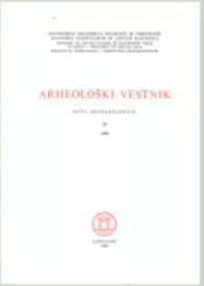A Warrior’s Grave at Turnišče near Ptuj
Abstract
In 1949 while working at Ptuj and its surroundings the Archaeo[1]logical Section was investigating the place called Suha veja near the castle of Turnišče in the surroundings of Ptuj. During the in[1]vestigations an Ancient Slav male skeleton was discovered. There[1]fore systematic researches were put off to the year 1950. The grave pit was dug into gravel about 80 cm deep. The ske[1]leton itself was lying in a kind of an unnailed-up coffin. The boards had been entirely carbonized already yet they still formed a re[1]gular quadrangle. The coffin was covered with a board as well. The position of the corpse was the usual one — west-eastwards, with a slight declination southwards. On the right side of the skeleton outside the coffin a broken pot containing two silexes was found. Inside the coffin itself ther were: on the right side at the height of the hip a battle knife-scramasax (21.4 cm long, the width of the blade being 5.7 cm), an entirely decayed smaller knife, a piece of a metal plate representing probably the iron work of the sheath, remains of leather, bronze ornamental nails, partly in leather yet, and a fragmentary tinder. On the left a bird’s skeleton was disco[1]vered under the ulna. As to its shape the pot represents hitherto, an isolated phenomenon. There are some convergent points with the pot found at Lišen — Staré Zâmky near Brno.2 It had been manu[1]factured first by hand; later it was finished up on a potter’s wheel with a small rotation power. The tinder represents an older form with a tongue its ends being but gently turned np. Analogous speci[1]mens are found in Germanic graves from earlier periods but also among the remnants on the Pannonian plain, and elsewhere. The battle knife i a typical weapon of Germanic people; yet now it has been found in Slav necropoles as well, especially in those of Slo[1]venia. Considering all its elements the grave of Turnišče might be assigned to the end of 8th or to the beginning of 9th centuries (richly furnished graves, especially by weapons, and the bird’s skeleton). It is, however, impossible to define this grave more exactly: whether it belongs to the Keszthely period or to the transition between the Keszthely and the Bijelo Brdo cultures
Downloads
Downloads
Published
How to Cite
Issue
Section
License

This work is licensed under a Creative Commons Attribution-NonCommercial-ShareAlike 4.0 International License.
Authors guarantee that the work is their own original creation and does not infringe any statutory or common-law copyright or any proprietary right of any third party. In case of claims by third parties, authors commit their self to defend the interests of the publisher, and shall cover any potential costs.
More in: Submission chapter





